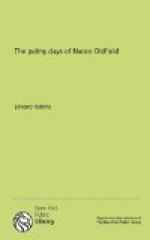Perhaps the reader may think that this chapter, like several others, is (as the theatre-goer said of “Hamlet”) too “deuced full of quotation.” Yet what can give a better picture of old stage life than these quaint and often eloquent records of the past? Pray be lenient, therefore, thou kindly critic, if the most faded books of the theatrical library are taken down from the dusty shelf, and a few of the neglected pages are printed once again. As these very books seem all the better in their dingy bindings, so do the old ideas, the odd conceits, the stories that charmed dead generations, take on a keener zest when clothed in the formal language of other days.
If we want to get that formal language in all its glory, let us bring from the library a copy of some early eighteenth-century tragedy. Shall we close our eyes and choose one at random? Well, what have we? The “Tamerlane” of our friend Nicholas Rowe, in which is set forth the story of the generous Emperor of Tartary, the “very glass and fashion of all conquerors.” The play is prefaced by a fulsome “Epistle Dedicatory,” addressed to the sacred person of the “Right Honourable William, Lord Marquis of Harrington,” and showing, almost pathetically, how frequently the literary workers of Queen Anne’s “golden age” were wont to beg the influence of some powerful patron. The dedication seems absolutely grovelling when viewed from the present standards, but Mr. Rowe and his friends saw therein nothing more remarkable than respectful homage to one of the world’s great men. The republic of letters was then an empty name.[A]
[Footnote A: “Tamerlane” was brought out in 1702, with Betterton in the title role.]
The author of “Tamerlane” fears that in thus calling attention to the play he may appear guilty of “impertinence and interruptions,” and, he adds, “I am sure it is a reason why I ought to beg your Lordship’s pardon, for troubling you with this tragedy; not but that poetry has always been, and will still be the entertainment of all wise men, that have any delicacy in their knowledge.” Then, after wasting a little necessary flattery on the noble marquis, he starts off into an unblushing eulogy of King William III., whose clemency was mirrored, supposedly, by the hero of the tragedy. “Some people [who do me a very great honour in it] have fancy’d, that in the person of Tamerlane, I have alluded to the greatest character of the present age. I don’t know whether I ought not to apprehend a great deal of danger from avowing a design like that: It may be a task indeed worthy of the greatest genius, which this or any other time has produc’d; but therefore I ought not to stand the shock of a parallel lest it should be seen, to my disadvantage, how far the Hero has transcended the poet’s thoughts”—and so on, ad nauseam.
To turn the leaves of the play, after wading through the slime of the “Epistle,” is to find amusing proof of the high-flown and at times bombastic expression which elicited such admiration from audiences of the old regime. (Do not laugh at it, reader; you tolerate an equal amount of absurdity in modern melodrama). The very first lines are charmingly suggestive of the starched and stately past. “Hail to the sun!” says the Prince of Tanais:




